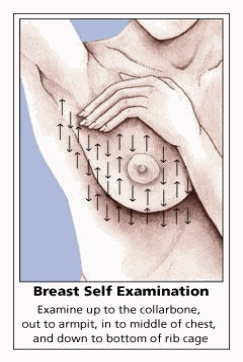 Image to the left taken from Cancer.org.
Image to the left taken from Cancer.org.
Self-exams help you to detect changes in your body between visits to your doctor. Many lives have been saved due to diligent self-examination, and following are two self-exams you’ll want to perform regularly.
BSE or breast self-exam
Each woman has her own method of examining her breasts. Some do a systematic BSE monthly or bimonthly, while others keep an eye on their breasts by regularly feeling them in the shower or while lying in bed. Often, women ask their significant others to help them check, or they visit the doctor several times a year for a clinical exam.
While a regular BSE with a consistent technique is best, perfect technique is not as important as frequency and diligence. Sometimes, women stress needlessly about doing it correctly. As long as you feel the entire breast and overlap your motions, you’re doing it right. The goal of a BSE is to know what is normal for you and check for changes.
If you’re not sure whether you’re feeling the entire breast, cancer.org suggests the following BSE routine:
- Lie down and bend your arm behind your head to spread the breast tissue evenly over your chest, making it easier to examine.
- Imagine your breast is divided in vertical lines from your underarm to breastbone, and use the finger pads of your other hand to feel for lumps in an up-and-down pattern along those lines. Move in dime-sized circles, slightly overlapping the previous line as you move up and down.
- Use different levels of pressure at each spot so you feel all the breast tissue, especially if you have large breasts. You can feel the tissue close to the skin with light pressure, tissue in the upper half of the breast with medium pressure, and lower breast tissue with deeper pressure. There will be a ridge at the bottom of each breast, which is normal. If you have questions about pressure, talk with your doctor or nurse.
- Examine the entire breast area, and then repeat the exam on your other breast.
- Stand in front of a mirror, press your hands on your hips, and look at your breasts for changes in shape or size. Also look for rashes, redness, or dimpling.
- Raise each arm slightly, and feel the underarm for lumps.
Some women may find it easier to examine their breasts in the shower, which is fine, as long as you are thorough—or add this routine to your shower exam. Current medical literature suggests that the above procedure is the most effective for finding lumps as soon as possible.
Skin exam
A regular skin exam will help you keep an eye on moles, freckles, and other spots that could become cancerous. It should be done at least once a month, and if you ask your doctor to do a full-body exam first, you’ll have a baseline. While it may sound daunting, after you’ve done a full skin exam a couple of times, it shouldn’t take more than 10–15 minutes.
Warning signs of skin cancer include a change in an existing mole or spot, or any growth or spot that . . .
- Appears during adulthood.
- Increases in size or thickness.
- Changes in texture or in color—especially if it turns pearly, multicolored, brown, or black.
- Has an irregular shape or outline.
- Is bigger than a pencil eraser.
- Continues to hurt, itch, scab, or bleed longer than three weeks.
If you see any of these signs, don’t wait or hope it goes away. See a doctor, preferably a dermatologist.
Loved this post and want to receive even more helpful tips? Sign up for our newsletter using the subscription box on the right sidebar.





